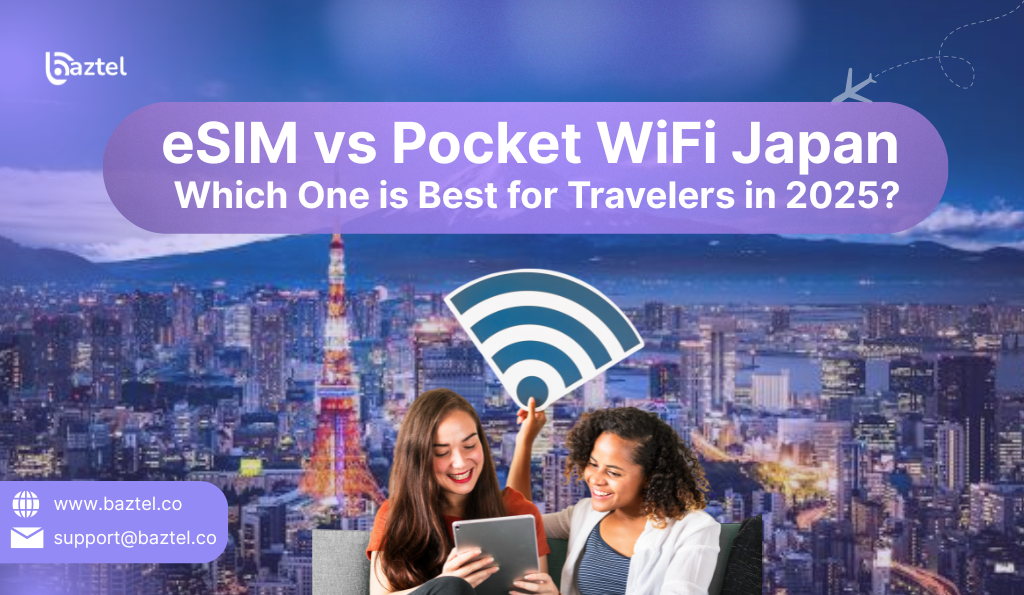If you are going to Japan in 2025, it is more important to be connected than ever. Whether you are looking for you through the lively neighborhood in Tokyo, searching for centuries old temples in Kyoto, or checking in a business call from Osaka, it does not have reliable internet help. While Japan is known for its advanced technology, public WiFi is not always available or consistent, especially when you enter the effort outside larger cities. This is the reason to choose the right way to stay online – whether you are through eSIM vs Pocket WiFi Japan – you can make a big difference in how smooth and nice your journey is.
The best connection options available for passengers are eSIM and Pocket WiFi routers. Both solutions provide different benefits, and choosing the right can lead to a significant difference in your travel experience. With new progress and updated travel trends in 2025, it is more important to understand which option meets your specific requirements.
In this blog, we’ll explore everything you need to know about Japan eSIM vs Pocket WiFi—including the key differences, pros and cons, pricing, and real-world travel scenarios—to help you choose the right option for your trip.
Why Choosing Between eSIM vs Pocket WiFi Japan Matters For Your Upcoming Travel in 2025?
In 2025, Japan will still take the lead in digital infrastructure, but many travelers are astonished to find that free public WiFi is still limited across various regions, particularly in rural or less commercial areas. Relying on hotel WiFi or crossing fingers to find café hotspots can really limit your travel experience.
This makes the use of mobile internet necessary – not only for simplicity, but also for navigation, translation, rides, restaurant reservation and even digital payments.
Choosing the wrong solution can result in:
- Unexpected roaming fees
- Slow data speeds
- Connectivity gaps in remote locations
- Unnecessary hardware to carry around
- Missed opportunities for seamless communication
Two most reliable options – eSIM vs Pocket WiFi Japan routes with powerful advantages, but in line with different types of travelers. Break them to help you choose with care.
Common Mistakes Travelers Make When Picking a Connectivity Option
Before diving deeper, it’s essential to understand where many travelers go wrong while choosing Japan eSIM vs Pocket WiFi:
- Ignoring device compatibility: Many travelers assume all smartphones support eSIMs, only to discover incompatibility after purchase.
- Assuming all data is truly unlimited: Many Pocket WiFi providers advertise unlimited data but implement “fair usage policies” that throttle speeds after a certain threshold.
- Forgetting about battery limitations: Pocket WiFi routers require daily charging. If you’re out all day without a power bank, you may end up disconnected.
- Purchasing local SIMs at airports: This is often more expensive and less flexible than ordering in advance.
- Not comparing real-world use cases: Many travelers do not consider how many devices they’ll be using, their travel group size, or duration—factors that strongly affect which option is better.
Avoiding these mistakes ensures smoother, stress-free connectivity during your trip.
eSIM vs Pocket WiFi Japan vs SIM Card: What’s the Difference?
Here’s a comparison to illustrate the key distinctions between these three options:
| Feature | eSIM | Pocket WiFi | Physical SIM Card |
| Form | Embedded digital SIM | Physical portable router | Traditional plastic SIM |
| Setup | QR code or app | Device pickup and manual setup | Manual insertion and configuration |
| Device Requirement | eSIM-compatible, unlocked smartphone | Any device with WiFi | Unlocked phone with SIM tray |
| Number of Devices Supported | One (phone or via hotspot) | Up to 10 devices | One device only |
| Battery Dependent | No | Yes, daily charging required | No |
| Portability | Lightweight, nothing extra to carry | Must carry router everywhere | No extra gear needed |
| Best For | Solo travelers | Families, groups, multi-device users | Budget travelers with no eSIM support |
What is Pocket WiFi and How Does It Work in Japan?
Pocket WiFi is a portable wireless router that connects to the mobile data network in Japan—most likely 4G or 5G—and creates a private WiFi network you can connect your devices to. These devices are preconfigured so you really do not have to have any technical knowledge to use them.
Here’s how it works:
- Rent a Pocket WiFi router online or at the airport
- Receive it by delivery or pick it up at designated counters
- Power it on, and connect your phone, tablet, or laptop
- Return the device at the end of your trip
While choosing between eSIM vs Pocket WiFi Japan, you need to consider the fact that Pocket WiFi routers are extremely popular for the usability of travelers, and gives better reliability in both cities and rural areas.
Pros and Cons of Pocket WiFi for Japan Trips
| Advantages | Disadvantages |
| Works with any WiFi-capable device | Requires carrying an extra device |
| Ideal for sharing with groups or families | Daily charging needed |
| No changes required to your phone’s SIM settings | Rental cost can be high for solo users |
| Stable, high-speed internet for streaming and video calls | Must be returned—risk of late fees or loss |
| Reliable coverage in both cities and remote areas | Slower speeds if too many devices connect simultaneously |
Pocket WiFi Battery Life & Rental Tips
Battery Life:
- Most Pocket WiFi devices provide 8 to 12 hours of usage on a full charge.
- Power-saving features can extend usage but may reduce signal strength.
- Carrying a portable power bank is highly recommended for all-day excursions.
Rental Tips:
- Order online in advance to ensure availability and better pricing.
- Choose airport pickup if you’re arriving during normal hours.
- Consider hotel delivery for added convenience.
- Return via prepaid mailers or airport kiosks to avoid penalties.
- Confirm data limits—many “unlimited” plans are subject to throttling after high usage.
What is an eSIM and How Does It Work in Japan?
An eSIM, or built -in sim, is a virtual SIM card made in your phone or device. Instead of inserting a physical card, download a mobile data plan from the eSIM provider through a QR code or mobile app.
When installed, the device connects to the local Japanese network – usually for the same functionality as soft bank, NTT DOCOMO or AU – a traditional SIM.
Here’s the step-by-step process:
- Choose an eSIM provider (like Airalo, Holafly, or Baztel)
- Purchase a plan suitable for your travel dates and data needs
- Receive a QR code or download instructions via email or app
- Install and activate the eSIM
- Start using data instantly upon arrival in Japan
How eSIMs Compare to Physical SIMs
- eSIMs don’t require swapping out your original SIM card
- Ideal for dual-SIM phones where you can keep your home number active
- You can manage multiple eSIM profiles in your phone simultaneously
- Often faster to set up and more convenient than buying SIM cards locally
Advantages and Disadvantages of eSIM in Japan
| Advantages | Disadvantages |
| No physical hardware or SIM card needed | Only works with eSIM-compatible phones |
| Instant activation from anywhere | Limited support for multi-device sharing |
| No need to pick up or return a device | Some providers throttle data after usage limits |
| Can keep home SIM active using dual-SIM | May require APN configuration on certain phones |
| Often more affordable than Pocket WiFi for individuals | Not ideal for shared usage among several users |
Device Compatibility Checklist for Japan eSIM
Before purchasing an eSIM plan, confirm your smartphone supports eSIM and is unlocked.
Compatible Devices:
Apple:
- iPhone XR, XS, and newer (iPhone 11, 12, 13, 14, 15, etc.)
- iPad Pro 11-inch and newer
Samsung:
- Galaxy S20, S21, S22, S23, and newer
- Galaxy Z Fold and Z Flip series
Google:
- Pixel 3 and later models
Others:
- Some Huawei, Motorola, Oppo, and Sony Xperia models (check the manufacturer specs)
To check eSIM compatibility:
- Go to Settings > Cellular > Add eSIM on your phone
Price Comparison of Top Providers in Japan (2025 Update)
Japan eSIM vs Pocket WiFi Cost Comparison (2025)
| Provider | Plan Name | Data Limit | Validity | Price |
| Airalo | Asakusa | 3GB | 7 Days | $9 |
| Holafly | Unlimited | Unlimited | 5 Days | $19 |
| Baztel | Tourist Basic | 5GB | 10 Days | $12 |
| Ubigi | Monthly Pack | 10GB | 30 Days | $19 |
| Ninja WiFi | Standard | Unlimited (Fair Use) | 7 Days | $35 |
| Japan Wireless | Premium | Unlimited (Fair Use) | 10 Days | $49 |
| SoftBank Rentals | High Usage | 100GB | 30 Days | $80 |
Activation Time & Ease of Setup
| Feature | eSIM | Pocket WiFi |
| Setup Time | Under 10 minutes | 15–30 minutes (pickup, instructions) |
| Required Hardware | No | Yes (router + charger) |
| Airport Pickup Needed | No | Often required |
| Starts Working On Arrival | Yes | Only if prearranged or picked up |
Verdict: When you have an option to choose between Japan eSIM vs Pocket WiFi, eSIM is significantly more convenient for travelers who want instant setup and no device hassle.
Speed, Reliability & Coverage
While comparing eSIM vs Pocket WiFi Japan, both use major cellular networks, offering excellent nationwide coverage. However, there are minor differences in experience.
| Factor | Winner |
| Speed in Urban Areas | Tie |
| Rural Area Performance | Pocket WiFi (external antennas help) |
| Data Throttling | eSIM (more plan variation) |
| Stability with Multiple Devices | Pocket WiFi |
Verdict: For most solo travelers, eSIM offers excellent performance. Pocket WiFi may be better in mountainous or rural areas.
Hotspot Sharing & Multi-Device Use
| Feature | eSIM | Pocket WiFi |
| Number of Devices | 1–2 (via phone hotspot) | 5–10 |
| Battery Dependency | Phone battery only | Requires charging |
| Ideal for Group Travel | No | Yes |
| Sharing Stability | May reduce phone speed | Stable router-based network |
Verdict: Pocket WiFi is best suited for families or travelers with multiple devices.
Security & Privacy
| Feature | eSIM | Pocket WiFi |
| Risk of Theft | Minimal | Moderate (device can be stolen) |
| Connection Security | High | High |
| SIM-Related Risks | None | Risk of loss incurs fines |
| Safer for Solo Use | Yes | No |
Which Should You Choose: Japan eSIM vs Pocket Wifi Based on Your Travel Style?
Best for Solo Travelers and Backpackers
- eSIM is the superior option. It’s lightweight, cost-effective, and doesn’t require you to carry extra equipment.
Best for Families and Groups
- Pocket WiFi is ideal, allowing multiple users to stay connected using one router. Data plans are generally more cost-effective when shared.
Best for Digital Nomads and Remote Workers
- If working remotely, both options are viable. Choose eSIM for mobility, or Pocket WiFi for stable high-volume usage and multi-device setups.
Best for Business Travelers
- eSIM is typically more secure, discreet, and efficient—ideal for professionals moving between cities or regions.
Pros & Cons Summary Table: Japan eSIM vs Pocket WiFi
| Feature | eSIM | Pocket WiFi |
| Cost | More affordable for solo use | Cost-effective for groups |
| Activation | Instant setup | Requires rental & pickup |
| Portability | No extra device needed | Must carry router |
| Speed & Coverage | Excellent | Excellent |
| Battery-Free | Yes | No |
| Sharing Capabilities | Limited | Strong |
| Security | Higher (less loss risk) | Lower (external device) |
Final Verdict: Japan eSIM vs Pocket Wifi Which is Better in 2025?
In 2025, choosing the right connection option for Japan’s own visit to a large extent of travel style and technical needs.
Talking about eSIM vs pocket WiFi Japan, eSIMs are ideal for single travelers, backpackers, digital nomads and professional professionals who prefer convenience and minimalism. To carry a physical hardware, with quick activation and cheap prices through the QR code or app, provides a streamlined solution to keep in touch. You can keep the primary number actively using double SIM functionality and avoid hating or avoiding the problems of return equipment. This is perfect for light passengers who want flexibility and quickly use the Internet on arrival.
On the other hand, Pocket WiFi is an intelligent option for families, travel groups or users with multiple equipment. This allows 10 units to be connected at the same time, which makes it cost -effective when divided. Although this requires daily charging and several devices that carry, its strong coverage and stable speed are valuable for streaming, video conferences or retain everything. For long journeys, it often offers GB and continuous performance, especially in rural areas.
FAQs About eSIM vs Pocket WiFi Japan
Do I need an unlocked phone for Japan eSIM?
Yes, to install and activate an eSIM in Japan, you must have the phone company-unlock. Locked phones will not support the eSIM connection with international suppliers.
Is pocket WiFi still worth it in 2025?
Yes. It’s worth asking before comparing Japan eSIM vs Pocket WiFi. The Pocket WiFi 2025 is still a reliable option for passengers who require a stable Internet in 2025, especially when streaming, long -term stays or sharing connections on many units with family or colleagues.
Can I use both eSIM and Pocket WiFi together?
Yes, you can use both together. eSIM is great for moving personal use, while Pocket WiFi helps share the Internet with other devices or passengers in your group.
For long trips in Japan, which is the best?
For more than 2-3 weeks of trips, the pocket is ideal for WiFi sharing and stability. eSIM suits single travelers seeking facilities, light trips and monthly computer programs without extra hardware.
Blog Author
Peter
Peter started BazTel.co to make mobile internet easier for travellers. He noticed how tough it was to find good network options while visiting new countries. That’s when he built BazTel — a place where anyone can buy eSIMs online without confusion or long steps. He believes tech should be simple and useful, not complicated. When he’s free, he likes to travel, test BazTel himself, and keep improving it based on real user problems.

 Botswana
Botswana Zambia
Zambia Congo
Congo Colombia
Colombia China mainland
China mainland Chile
Chile Chad
Chad Central African Republic
Central African Republic Canada
Canada Cameroon
Cameroon Cambodia
Cambodia Burkina Faso
Burkina Faso Bulgaria
Bulgaria Brunei Darussalam
Brunei Darussalam Brazil
Brazil Aland Islands
Aland Islands Bosnia and Herzegovina
Bosnia and Herzegovina Bolivia
Bolivia Belgium
Belgium Belarus
Belarus Bangladesh
Bangladesh Bahrain
Bahrain Azerbaijan
Azerbaijan Austria
Austria Australia
Australia Armenia
Armenia Argentina
Argentina Algeria
Algeria



